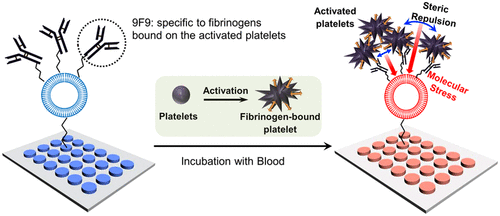Our official English website, www.x-mol.net, welcomes your
feedback! (Note: you will need to create a separate account there.)
Polydiacetylene Liposome Microarray toward Facile Measurement of Platelet Activation in Whole Blood
ACS Sensors ( IF 8.2 ) Pub Date : 2021-07-22 , DOI: 10.1021/acssensors.1c01167 Deokwon Seo 1, 2 , Terry C Major 3 , Do Hyun Kang 2 , Sungbaek Seo 4 , Kangwon Lee 1 , Robert H Bartlett 3 , Jinsang Kim 2, 4, 5, 6, 7
ACS Sensors ( IF 8.2 ) Pub Date : 2021-07-22 , DOI: 10.1021/acssensors.1c01167 Deokwon Seo 1, 2 , Terry C Major 3 , Do Hyun Kang 2 , Sungbaek Seo 4 , Kangwon Lee 1 , Robert H Bartlett 3 , Jinsang Kim 2, 4, 5, 6, 7
Affiliation

|
The necessity of a simple measurement of platelet activation has been increasing in clinical medicine to regulate the proper dose of the antiplatelet drugs for patients having clinical outcomes in acute situations such as angina pectoris, stroke, or peripheral vascular disease or procedures involving angioplasty or coronary thrombolysis. We developed a self-signaling polydiacetylene (PDA) liposome microarray to detect activated platelets from whole blood samples in a single step. A specific antibody, 9F9 antibody, to platelet-bound fibrinogen was selected and conjugated to the PDA liposome microarray to quantify the fibrinogen-bound platelets. The developed PDA liposome–9F9 microarray generated an intense fluorescence signal when activated platelets in whole blood were introduced and also successfully distinguished the reduced platelet activation in the presence of Tirofiban, a model antiplatelet drug. The results of this single-step benchtop assay incorporates simple, sensitive, and rapid attributes that can detect the extent of platelet activation prior to needed clinical procedures.
中文翻译:

聚二乙炔脂质体微阵列用于轻松测量全血中的血小板活化
在临床医学中,对血小板活化的简单测量的必要性日益增加,以调节在急性情况下具有临床结果的患者的抗血小板药物的适当剂量,例如心绞痛、中风或外周血管疾病或涉及血管成形术或冠状动脉溶栓的程序. 我们开发了一种自信号聚二乙炔 (PDA) 脂质体微阵列,可在一个步骤中检测全血样本中的活化血小板。选择了一种针对血小板结合纤维蛋白原的特异性抗体 9F9 抗体,并将其与 PDA 脂质体微阵列结合以量化结合纤维蛋白原的血小板。当引入全血中活化的血小板时,开发的 PDA 脂质体-9F9 微阵列会产生强烈的荧光信号,并且还成功区分了在替罗非班(一种模型抗血小板药物)存在下血小板活化的减少。这种单步台式检测的结果具有简单、灵敏和快速的特性,可以在所需的临床程序之前检测血小板活化的程度。
更新日期:2021-09-24
中文翻译:

聚二乙炔脂质体微阵列用于轻松测量全血中的血小板活化
在临床医学中,对血小板活化的简单测量的必要性日益增加,以调节在急性情况下具有临床结果的患者的抗血小板药物的适当剂量,例如心绞痛、中风或外周血管疾病或涉及血管成形术或冠状动脉溶栓的程序. 我们开发了一种自信号聚二乙炔 (PDA) 脂质体微阵列,可在一个步骤中检测全血样本中的活化血小板。选择了一种针对血小板结合纤维蛋白原的特异性抗体 9F9 抗体,并将其与 PDA 脂质体微阵列结合以量化结合纤维蛋白原的血小板。当引入全血中活化的血小板时,开发的 PDA 脂质体-9F9 微阵列会产生强烈的荧光信号,并且还成功区分了在替罗非班(一种模型抗血小板药物)存在下血小板活化的减少。这种单步台式检测的结果具有简单、灵敏和快速的特性,可以在所需的临床程序之前检测血小板活化的程度。











































 京公网安备 11010802027423号
京公网安备 11010802027423号